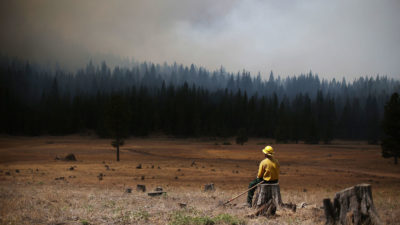Aproximadamente 20% das emissões de gases do efeito estufa são causadas pelo desmatamento, revela relatório da FAO
Desmatamento é 2ª maior causa das mudanças climáticas
ONU
As florestas são aliadas do homem no combate às mudanças climáticas,
absorvendo por ano cerca de 2 bilhões de toneladas de CO2. Mas quando
são desmatadas, as coberturas vegetais do planeta se transformam em
motores do aquecimento global. Aproximadamente 20% das emissões de gases
do efeito estufa são causadas pelo desmatamento. Em relatório divulgado
neste mês (6), a Organização das Nações Unidas para a Alimentação e
Agricultura (FAO) identifica um aumento na destruição das superfícies
verdes do planeta.

De 1990 e 2015, a área da Terra coberta por florestas caiu de 31,6% para 30,6%. A agência da ONU aponta que o desmatamento é a segunda maior causa das mudanças climáticas, ficando atrás apenas da queima de combustíveis fósseis. As emissões geradas pela destruição da cobertura vegetal são maiores que as de todo o setor de transporte.
O levantamento da FAO revela ainda que a interrupção ou redução do desmatamento em zonas tropicais responderia por até 30% da capacidade de mitigar as mudanças climáticas.
Um obstáculo à proteção das florestas é o consumo de carvão vegetal. Nas regiões em que a demanda é alta, a produção exerce pressão sobre os recursos florestais e contribui para a degradação dos ecossistemas, especialmente quando o acesso às florestas não está regulamentado. Segundo o estudo da FAO, a população que depende de lenha varia de 63% na África a 38% na Ásia e 16% na América Latina.
Os continentes africano e sul-americano também estão na contramão do uso sustentável das superfícies verdes. Nos últimos 25 anos, cresceram no mundo as florestas manejadas para a conservação dos solos e das águas, mas essa expansão não foi verificada na África nem na América do Sul. Os territórios utilizados de maneira responsável representam hoje 25% de toda a cobertura vegetal do planeta. Nos países sul-americanos, o índice cai para apenas 9%.
Pobreza e meio ambiente
De acordo com a FAO, florestas são fonte de 20% da renda de famílias rurais em países em desenvolvimento. O relatório do organismo internacional alerta para uma estreita relação entre cobertura florestal e altas taxas de pobreza — no Brasil, por exemplo, pouco mais de 70% das áreas de florestas fechadas (densas, com grande cobertura de copa) apresentavam índices elevados de miséria.A publicação mostra ainda que, na América Latina, 8 milhões de pessoas sobrevivem com menos de 1,25 dólares por dia nas regiões de florestas tropicais, savanas e seus arredores. Mundialmente, mais de 250 milhões de indivíduos vivem abaixo da linha da pobreza extrema nessas áreas: 63% estão na África, 34% na Ásia e 3% na América Latina.
Apesar da pequena participação da América Latina no total global, a FAO destaca que, nas zonas rurais latino-americanas, 82% das pessoas vivendo abaixo da linha da pobreza estão em florestas tropicais, savanas e seus arredores. Essas regiões de mata são o lar de 85 milhões de pessoas na região.
Parque da Tijuca é exemplo de conservação
Destaque no relatório da FAO, o Parque Nacional da Tijuca, no Rio de Janeiro, tem uma superfície de 4 mil hectares e foi declarado Patrimônio da Humanidade pela UNESCO em 2012.A pesquisa da agência da ONU lembra que, para enfrentar a proliferação de espécies exóticas e a expansão urbana, a área foi reflorestada com árvores nativas. O governo também criou espaços recreativos para envolver a comunidade local e aumentar a conscientização sobre a proteção das florestas urbanas.
Desde 1999, o parque é administrado conjuntamente pela Prefeitura do Rio e pelo Ministério do Meio Ambiente. Atualmente, o local recebe 2,5 milhões de visitantes por ano e é um exemplo de restauração da Mata Atlântica. A reserva transformou-se num santuário para diversas espécies endêmicas.
Empresas florestais comunitárias na Guatemala
Na Guatemala, 70% das terras florestais estão sob algum tipo de proteção. Com concessões do governo, empresas comunitárias gerenciam mais de 420 mil hectares dentro da Reserva da Biosfera Maia. Em apenas um ano, de 2006 a 2007, as companhias obtiveram receitas de 4,75 milhões de dólares pela venda de madeira certificada. Outros 150 mil dólares vieram do comércio de produtos florestais não-madeireiros.As cooperativas geraram mais de 10 mil empregos diretos e outros 60 mil indiretos. As instituições também pagavam aos trabalhadores mais que o dobro do salário normal, segundo dados coletados pela FAO.
Costa Rica: florestas e turismo
A Costa Rica é um dos principais destinos de turismo ecológico do mundo: em 2016, 2,9 milhões de turistas estrangeiros visitaram o país e 66% deles afirmaram que o ecoturismo era um dos principais motivos da viagem.Os visitantes gastaram em média 1.309 dólares por pessoa, trazendo uma renda para o país de 2,5 bilhões de dólares. Isso equivale a 4,4% do Produto Interno Bruto (PIB) do país. Uma parte do montante pode ser atribuída ao ecoturismo. Em 2015, apenas as áreas de conservação florestal receberam aproximadamente 1 milhão de estrangeiros e outros 900 mil turistas nacionais.
Acesse o relatório da FAO “Estado das Florestas no Mundo” na íntegra clicando aqui (em inglês).
Da ONU Brasil, in EcoDebate, ISSN 2446-9394, 12/07/2018











